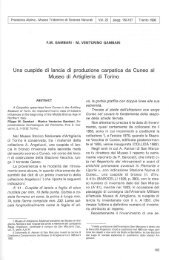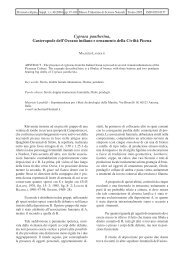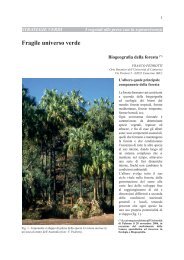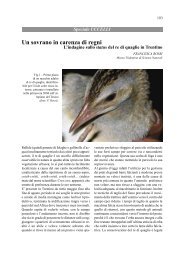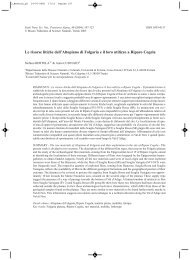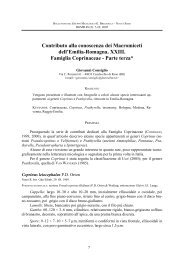Science at Museo delle Scienze - Museo Tridentino di Scienze ...
Science at Museo delle Scienze - Museo Tridentino di Scienze ...
Science at Museo delle Scienze - Museo Tridentino di Scienze ...
You also want an ePaper? Increase the reach of your titles
YUMPU automatically turns print PDFs into web optimized ePapers that Google loves.
The main results and projects 2010-2011<br />
a new method to identify important conserv<strong>at</strong>ion areas applied to<br />
the alpine invertebr<strong>at</strong>es<br />
Section of Invertebr<strong>at</strong>e Zoology and Hydrobiology<br />
invertebr<strong>at</strong>es constitute a substantial<br />
proportion of terrestrial and freshw<strong>at</strong>er<br />
bio<strong>di</strong>versity and are critical to ecosystem<br />
functions. however, their inclusion in<br />
prioritiz<strong>at</strong>ion and conserv<strong>at</strong>ion planning<br />
is underconsidered, in particular in the<br />
Alps.<br />
We coor<strong>di</strong>n<strong>at</strong>ed a project where we<br />
proposed a new methodological solution<br />
and challenge for the identific<strong>at</strong>ion<br />
of priority areas based on the integr<strong>at</strong>ion<br />
of three approaches: invertebr<strong>at</strong>e<br />
multi-taxa based, expert-based, and<br />
Gis-based. The Trentino Province (eastern<br />
italian Alps), was investig<strong>at</strong>e as case<br />
study.<br />
The first methodological step was to<br />
select a panel of nineteen experts which<br />
played a str<strong>at</strong>egic role in the suggestion<br />
of 229 species, endangered or of mand<strong>at</strong>ory<br />
conserv<strong>at</strong>ion interest. The second<br />
step was to find objective criteria for species<br />
prioritis<strong>at</strong>ion. These criteria, crossed<br />
with the experts taxonomical and ecological<br />
knowledge resulted in a list of<br />
70 focal invertebr<strong>at</strong>e species. The third<br />
step was to integr<strong>at</strong>e with the Gis-based<br />
approach d<strong>at</strong>a layers from the habit<strong>at</strong><br />
requirements of each of the seventy focal<br />
species to gener<strong>at</strong>e potential sp<strong>at</strong>ial<strong>di</strong>stributional<br />
maps. Potential <strong>di</strong>stribution<br />
maps gave inform<strong>at</strong>ion about the sites<br />
(priority areas) in which the highest number<br />
of focal species could concentr<strong>at</strong>e,<br />
thus suggesting where to concentr<strong>at</strong>e<br />
future monitoring efforts. several priority<br />
areas resulted outside the protected<br />
ones.<br />
Alluvial forest and hop-hornbeam<br />
woods resulted to be the habit<strong>at</strong>s with<br />
the highest number of focal species, and<br />
thus they represent the habit<strong>at</strong>s of major<br />
conserv<strong>at</strong>ion priority. Besides, they are<br />
usually small, fragmented, and nearing<br />
proximity of urbanized areas loc<strong>at</strong>ed in<br />
the bottom of the valleys.<br />
The rel<strong>at</strong>ively simple processes involved<br />
in species and potential habit<strong>at</strong><br />
<strong>di</strong>stribution produced with this research<br />
can be conducted with a sustainable effort,<br />
making it an <strong>at</strong>tractive tool when<br />
time and funds are in short supply.<br />
Gobbi, M., Riserv<strong>at</strong>o, e., Bragalanti, n.,<br />
& lencioni, V. (in press) An expert-based approach<br />
to invertebr<strong>at</strong>e conserv<strong>at</strong>ion: identific<strong>at</strong>ion<br />
of priority areas in central-eastern Alps.<br />
Journal for N<strong>at</strong>ure Conserv<strong>at</strong>ion.<br />
27<br />
1R 1r<br />
2R<br />
3R<br />
4R<br />
5R<br />
6R



